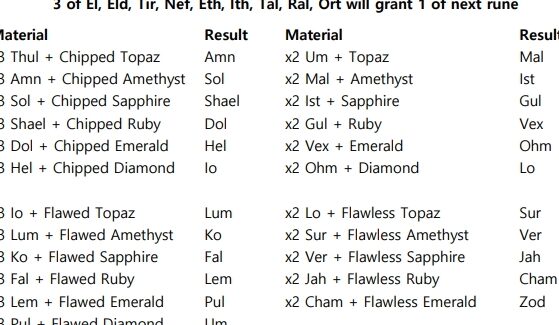Runes in Diablo 2 Resurrected: list, how to get them and attributes
Runes in Diablo 2 Resurrected: List, How to Get Them, and Attributes
Welcome, fellow adventurers! If you’ve dived into the world of Diablo 2 Resurrected, you’ve likely encountered the mystical items known as runes. These tiny yet powerful objects can significantly enhance your gameplay. Ready to explore the depths of these enchanting artifacts? Let’s dive in!
Introduction to Runes
Runes are more than just collectible items in Diablo 2 Resurrected; they hold the key to unlocking powerful gear and abilities. Whether you’re a seasoned player or just starting out, understanding runes can elevate your gaming experience. They can be inserted into weapons, shields, and armor, bestowing various attributes that can turn the tide of battle in your favor.
What Are Runes?
So, what exactly are runes? In simple terms, they are magical items that can be socketed into gear. Each rune has its own unique attributes that can modify the equipment it’s placed in. This mechanic is one of the reasons why players love Diablo 2 Resurrected so much; it adds a layer of strategy and customization that keeps you coming back for more.
The Significance of Runes
Runes serve multiple purposes in the game. They can enhance your character’s abilities, provide additional stats, and even allow you to create powerful runewords. By combining different runes in specific items, you can create gear that perfectly suits your playstyle. Imagine wielding a weapon that not only deals massive damage but also grants you health regeneration! Who wouldn’t want that?
List of Runes in Diablo 2 Resurrected
Let’s break down the runes you can find in Diablo 2 Resurrected. Each rune varies in level and attributes, so it’s crucial to know what’s out there. Here’s a comprehensive list:
Low-Level Runes
- El: +1 Energy, +2 to Mana after each kill
- Eld: +10% Enhanced Damage, +1 to Maximum Damage
- Tir: +1 to Dexterity, +2 to Mana after each kill
- Nef: +2 to Strength, +5 to Defense
- Eth: +20% Faster Run/Walk, +10 to Energy
Mid-Level Runes
- Ith: +20% Enhanced Damage, +30 to Mana
- Tal: +15% Enhanced Damage, +50 to Life
- Ral: +10 to Strength, +15% Enhanced Damage
- Ort: +5 to Energy, +10 to Mana
- Sol: +20% Enhanced Defense, +10 to Energy
High-Level Runes
- Lem: +5 to Dexterity, +20% Enhanced Defense
- Pul: +5 to Energy, +15% Enhanced Damage
- Um: +10% Enhanced Damage, +20% Enhanced Defense
- Mal: +15% Enhanced Defense, +10 to Strength
- Ist: +20% Magic Find, +10 to Energy
How to Obtain Runes
Now that you know the runes, you’re probably wondering how to get your hands on them. Don’t worry; I’ve got you covered! Here are the best ways to farm and obtain runes in Diablo 2 Resurrected.
Rune Drops from Monsters
One of the primary ways to acquire runes is by defeating monsters. Certain monsters have higher drop rates for specific runes, so it pays to know where to farm. For instance, monsters in the Hell difficulty level are more likely to drop higher-level runes. Pay attention to the types of monsters you’re battling, as some are known for dropping rare items!
Chests and Containers
Don’t forget about chests and containers scattered throughout the game. These can yield some surprising loot, including runes. Be sure to open every chest you come across, especially in high-level areas where the chances of finding something valuable increase significantly.
Trading for Runes
If you’re not having much luck with drops, consider trading with other players. The Diablo community is vibrant, and many players are willing to trade runes for items or other runes. You might be surprised at what you can get in return for something you don’t need!
Rune Crafting
Another exciting method to obtain runes is through crafting. By combining lower-tier runes, you can create higher-tier ones. This can be a game-changer if you’re struggling to find specific runes. Just remember, crafting requires some planning, so make sure you know which runes you need before you start!
Understanding Rune Attributes
Runes are not just random items; they come with their own set of attributes. Understanding these attributes can help you make informed decisions about which runes to use. Let’s delve into some of the common rune attributes you’ll encounter.
Common Attributes of Runes
Runes typically provide either offensive or defensive attributes. Depending on your playstyle, you’ll want to focus on different types of attributes.
Offensive Attributes
Offensive attributes generally enhance your damage output, making your character a fierce force on the battlefield. These include increased attack damage, enhanced critical strike chance, and bonuses to spell damage. If you’re all about dealing damage, look for runes that emphasize these stats.
Defensive Attributes
On the flip side, defensive attributes help with survivability. These can include increased defense rating, damage reduction, and bonuses to resistances. If you’re more of a tank or playing a character that needs to withstand heavy damage, prioritize runes that boost your defensive capabilities.
Rune Combinations and Runewords
Now, let’s talk about the magic of rune combinations. When you slot runes into specific items in the correct order, you can create what’s known as a runeword. This is where the real fun begins!
What are Runewords?
Runewords are unique item enhancements that can drastically improve your gear. Each runeword requires a specific combination of runes and can provide powerful effects that are not available through regular rune attributes. This feature adds a layer of strategy to your equipment choices.
Popular Runewords in Diablo 2
Some fan-favorite runewords include:
- Enigma: Grants teleportation, a must-have for faster gameplay.
- Call to Arms: Boosts stats and provides a massive battle cry.
- Heart of the Oak: Provides great bonuses for casters.
- Spirit: Excellent for shields, offering a well-rounded stat boost.
- Breath of the Dying: An ultimate damage dealer for melee characters.
Tips for Farming Runes
Ready to become a rune-farming expert? Here are some tips to help you maximize your rune drops and get the runes you need.
Efficient Farming Routes
Knowing where to farm is half the battle. Certain areas in the game are notorious for their rune drops. Consider farming locations like the Chaos Sanctuary or the Worldstone Keep, where high-level monsters are abundant. Make a farming route and stick to it; consistency is key!
Using Magic Find Gear
Magic Find gear can significantly increase your chances of finding rare items, including runes. Equip gear that has Magic Find bonuses to maximize your loot potential. Keep an eye out for items that enhance your Magic Find percentage, and don’t be afraid to swap out gear when you’re in farming mode!
Runes in Diablo 2 Resurrected are more than just collectibles; they’re essential for enhancing your gameplay experience. By understanding their attributes, how to obtain them, and how to create powerful runewords, you can elevate your character to new heights. So get out there, start farming, and unlock the full potential of your gear with these magical items!
FAQs
1. Can I stack multiple runes in one item?
No, you can only socket one rune per socket in an item, but you can combine runes in different items to create powerful runewords.
2. Are all runes equally valuable?
No, runes vary in value based on their level and the attributes they provide. Higher-level runes are generally more sought after.
3. Can I find runes in normal difficulty?
Yes, you can find runes in normal difficulty, but the higher-level runes are more likely to drop in Nightmare and Hell difficulties.
4. What is the best way to trade for runes?
The best way to trade is to participate in the community, using forums or in-game chats to find players willing to trade.
5. How do runewords work?
Runewords are created by socketing specific combinations of runes into an item in the correct order, providing unique bonuses and enhancements.



























Post Comment